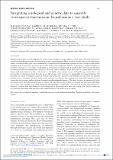Integrating serological and genetic data to quantify cross-species transmission: brucellosis as a case study

View/
Date
2016-03-03Author
Viana, Mafalda
Shirima, Gabriel
John, Kunda
Fitzpatrick, Julie
Kazwala, Rudovick
Buza, Joram
Cleaveland, Sarah
Haydon, Daniel
Halliday, Jo
Metadata
Show full item recordAbstract
Epidemiological data are often fragmented, partial, and/or ambiguous and unable to yield the desired level of understanding
of infectious disease dynamics to adequately inform control measures. Here, we show how the information contained in
widely available serology data can be enhanced by integration with less common type-specific data, to improve the understanding
of the transmission dynamics of complex multi-species pathogens and host communities. Using brucellosis in
northern Tanzania as a case study, we developed a latent process model based on serology data obtained from the field,
to reconstruct Brucella transmission dynamics. We were able to identify sheep and goats as a more likely source of
human and animal infection than cattle; however, the highly cross-reactive nature of Brucella spp. meant that it was
not possible to determine which Brucella species (B. abortus or B. melitensis) is responsible for human infection. We
extended our model to integrate simulated serology and typing data, and show that although serology alone can identify
the host source of human infection under certain restrictive conditions, the integration of even small amounts (5%) of
typing data can improve understanding of complex epidemiological dynamics. We show that data integration will often
be essential when more than one pathogen is present and when the distinction between exposed and infectious individuals
is not clear from serology data. With increasing epidemiological complexity, serology data become less informative.
However, we show how this weakness can be mitigated by integrating such data with typing data, thereby enhancing
the inference from these data and improving understanding of the underlying dynamics.
